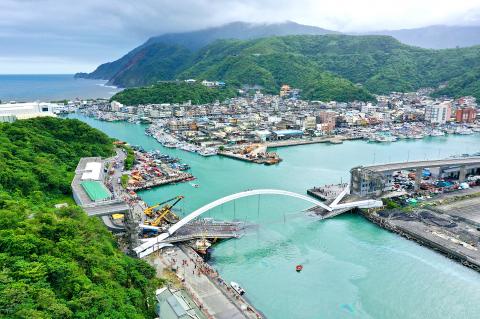Yesterday’s collapse of the Nanfangao Bridge (南方澳橋) in Yilan County might have been due to rusted anchoring points, Taipei Technology College of Engineering dean Sung Yu-chi (宋裕祺) said.
Video footage showed that the vertical cable at the center of the bridge’s steel arch was the first to snap, Sung said.
However, the bridge is suspended by 10 or more steel cables and theoretically, the other cables should have been capable of evenly distributing the weight the broken cable had borne, he said.

Photo: Peter Lo, Taipei Times
However, it looks like the snapping of the vertical cable caused a domino effect, Sung said.
The bridge was continuously exposed to salty air, which would have rusted the cables, reducing the amount of weight the span could support, Sung said.
Long-term exposure to wind could have also loosened the anchor points, making them unable to sustain the bridge’s weight, he said.
The collapse of the arch was caused by the dissolution of the force equilibrium between the bridge and the arch, although an investigation is needed to confirm the cause, he said.
Bridges are designed with safety factors and mechanisms taken into account, and routine inspections and precise equipment calibrations are required to maintain normal operations, he said.
Wang Chung-yu (王仲宇), a professor of civil engineering at National Central University, also said the cables could have rusted.
Strong winds brought by Typhoon Mitag would have caused the cables to sway constantly, which could have forced the cables to the point of snapping, Wang said.
An site inspection to determine which anchor point broke first is required, he said.
Authorities should make precise records of the site to compare with the records of the bridge’s last inspection, which could help clarify what happened, Wang said.
The bridge was an older design, created when the idea of protection from natural erosion was not yet popular, and it was possible that maintenance checks could have overlooked such possibilities, he added.
However, he believes that Mitag should be blamed for the collapse.
Taiwan International Ports Corp (TIPC) said it has conducted routine annual maintenance since the bridge was completed 21 years ago and, per regulations, each cable cord was inspected every four years.
The last inspection was conducted in 2016, when the Yilan County Government awarded the commission to Chien Hsin University of Technology and Science, TIPC said.
The university’s report suggested reinforcing the bridge body with concrete, removing rust from the cable beams, repairing the downspouts and replacing the expansion joints of the angle iron, it said.
It budgeted NT$10 million (US$322,113 at the current exchange rate) between 2017 and last year to cover the repairs and reinforcements noted in the report, the company said.
TIPC chief executive Chen Shao-liang (陳邵良) declined to comment on whether the cables snapped first, saying only that the company would await the results of the investigations.
Additional reporting by Hsiao Yu-hsin

Beijing could eventually see a full amphibious invasion of Taiwan as the only "prudent" way to bring about unification, the US Department of Defense said in a newly released annual report to Congress. The Pentagon's "Annual Report to Congress: Military and Security Developments Involving the People's Republic of China 2025," was in many ways similar to last year’s report but reorganized the analysis of the options China has to take over Taiwan. Generally, according to the report, Chinese leaders view the People's Liberation Army's (PLA) capabilities for a Taiwan campaign as improving, but they remain uncertain about its readiness to successfully seize

Taiwan is getting a day off on Christmas for the first time in 25 years. The change comes after opposition parties passed a law earlier this year to add or restore five public holidays, including Constitution Day, which falls on today, Dec. 25. The day marks the 1947 adoption of the constitution of the Republic of China, as the government in Taipei is formally known. Back then the Chinese Nationalist Party (KMT) governed China from Nanjing. When the KMT, now an opposition party in Taiwan, passed the legislation on holidays, it said that they would help “commemorate the history of national development.” That

Trips for more than 100,000 international and domestic air travelers could be disrupted as China launches a military exercise around Taiwan today, Taiwan’s Civil Aviation Administration (CAA) said yesterday. The exercise could affect nearly 900 flights scheduled to enter the Taipei Flight Information Region (FIR) during the exercise window, it added. A notice issued by the Chinese Civil Aviation Administration showed there would be seven temporary zones around the Taiwan Strait which would be used for live-fire exercises, lasting from 8am to 6pm today. All aircraft are prohibited from entering during exercise, it says. Taipei FIR has 14 international air routes and

Snow fell on Yushan (Jade Mountain, 玉山) yesterday morning as a continental cold air mass sent temperatures below freezing on Taiwan’s tallest peak, the Central Weather Administration (CWA) said. Snowflakes were seen on Yushan’s north peak from 6:28am to 6:38am, but they did not fully cover the ground and no accumulation was recorded, the CWA said. As of 7:42am, the lowest temperature recorded across Taiwan was minus-5.5°C at Yushan’s Fengkou observatory and minus-4.7°C at the Yushan observatory, CWA data showed. On Hehuanshan (合歡山) in Nantou County, a low of 1.3°C was recorded at 6:39pm, when ice pellets fell at Songsyue Lodge (松雪樓), a